Mushroom Production Shows Promise with Invasive-Species Tree Logs
PR Newswire
WESTMINSTER, Colo., Oct. 15, 2024
An article in the latest issue of Invasive Plant Science and Management provides new insights on the varying potential for using invasive tree logs to grow edible, marketable mushrooms.
WESTMINSTER, Colo., Oct. 15, 2024 /PRNewswire-PRWeb/ -- An article in the latest issue of Invasive Plant Science and Management provides new insights on the varying potential for using invasive tree logs to grow edible, marketable mushrooms.
"Our research project demonstrated the viability of logs from invasive trees to produce edible mushrooms on small farms in the Southeastern United States as an additional income source," says the study's lead author, Kristen Bowers, Ph.D., New Mexico State University postdoc research scientist and USDA Agricultural Research Service (ARS) biological science technician, Tallahassee, Florida. "Producing edible mushrooms on invasive tree species was an efficient use of on-farm natural resources that enhanced the ecosystem, improved environmental quality, and protected biodiversity, in addition to maximizing the local food system."
Cutting down invasive trees and removing the waste generated by branches and trunks is often cost prohibitive. To help offset invasive tree removal expenditures, especially for small scale farmers, the study showed that at least Chinese tallowtrees (Triadica sebifera) could be cut and used at farms in northern Florida and southern Georgia to economically produce edible and marketable shiitake mushrooms (Lentinula edodes).
"Yield comparisons between logs of native oak species (commonly used to cultivate mushrooms) and Chinese tallowtree determined that oak logs produced roughly three times more shiitake mushrooms than the tallowtree logs," says Bowers. "However, the size of an individual mushroom was significantly larger for tallowtree logs, weighing over one ounce per mushroom, compared to the mushrooms produced on oak logs, weighing three-quarters ounce each."
Whereas Chinese tallowtrees did prove feasible for edible, marketable mushroom production, four other non-native tree species – the silktree, earleaf acacia, Chinaberry and paperbark tree – failed to produce enough to indicate feasibility in this study. "Not every invasive tree-species log can produce marketable mushrooms efficiently," says Bowers. "However, the takeaway from this study is that edible fungi can be used to recycle some invasive, nonnative trees, like the Chinese tallowtree, and transform their biomass into an income-producing resource."
Mushroom fungus helps speed log decomposition in areas that could be used as productive land. A weedy tree's ability to provide a substrate for mushroom production may provide landowners with an additional incentive to remove invasive trees and increase invasive tree removal rates.
"Throughout the United States, agricultural producers struggle to control and remove invasive trees on their land," adds Bowers. "So, this study shows feasibility for a new strategy to offset the cost of invasive trees, which can cause a significant reduction in productivity if left unchecked."
More information is available in the online article, "Use of nonnative, invasive tree logs for commercial mushroom production," published in Invasive Plant Science and Management, vol. 17, issue 2, by Cambridge University Press. Invasive Plant Science and Management is the official publication of the Weed Science Society of America.
About Invasive Plant Science and Management
Invasive Plant Science and Management is a journal of the Weed Science Society of America, a nonprofit scientific society focused on weeds and their impact on the environment. The publication presents peer-reviewed original research related to all aspects of weed science, including the biology, ecology, physiology, management and control of weeds. To learn more, visit http://www.wssa.net.
Media Contact
Antonio DiTommaso, Ph.D., Editor - Invasive Plant Science and Management, (607) 254-4702, ad97@cornell.edu
![]() View original content to download multimedia:https://www.prweb.com/releases/mushroom-production-shows-promise-with-invasive-species-tree-logs-302274862.html
View original content to download multimedia:https://www.prweb.com/releases/mushroom-production-shows-promise-with-invasive-species-tree-logs-302274862.html
SOURCE Editor - Invasive Plant Science and Management


